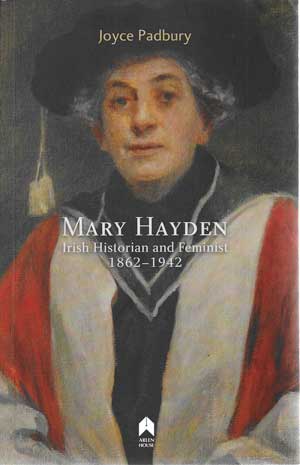MARY HAYDEN, IRISH HISTORIAN AND FEMINIST, 1862-1942
Published in Book Reviews, Book Reviews, Issue 5 (September/October 2022), Reviews, Volume 30JOYCE PADBURY
Arlen House
€25
ISBN 9781851322633
Reviewed by Eamonn O’Flaherty
Eamonn O’Flaherty is Associate Professor in the UCD Centre for the History of Medicine in Ireland.
Joyce Padbury’s biography of Mary Hayden explores the life and career of a woman who broke through a great many barriers to achieve independence, an academic career and a prominent place in the history of Irish feminism. Hayden did have some advantages, which helped her overcome the many obstacles to her ambitions. She was born in 1862 into a prosperous middle class family and her father was a professor in the Catholic University Medical School in Cecilia Street. Following her mother’s early death, Hayden’s father was an important influence in her life, encouraging her scholarly leanings and supporting her move to Alexandra College, where she encountered inspiring teachers like Alice Oldham and Isabella Mulvany. But Thomas Hayden seems to have thought that his daughter had had enough education by 1881, though Mary herself was hoping to be among the first women to matriculate as students of the newly-established Royal University (RU), whose degrees and awards were open to men and women. Thomas Hayden’s premature death in October 1881 left his daughter just enough financial independence to follow her ambition. No longer subject to the same parental and social pressures as her contemporaries, Hayden was able to steer a course through the restrictions on women of her background.
We know a great deal about Hayden’s emotional and intellectual development thanks to the extensive diaries she kept until 1903. Her impatience with the limitations imposed by lack of intellectual stimulation and a preoccupation with marriage increased her determination to be independent. On one occasion in 1883 she suspected that marriage would be ‘something like going to confession or getting teeth out, or passing an exam only much more exciting and dreadful’. When visiting her cousin Emmie Crean who married the wealthy Limerick merchant Sir Stephen Quinn, Hayden, when not hunting or horse-riding, preferred staying up late playing billiards and smoking with the men. She did have romantic relationships with men, refusing a number of marriage proposals, but preferred to retain her independence. She was able to do this during the 1880s and 1890s by augmenting her small income with scholarships and, in 1895, a junior fellowship in the Royal University worth £200 a year. Hayden’s efforts to improve the status of women in the university led to the first of the many campaigns, which formed a major part of her life’s work.
Hayden also pursued her independence by long periods abroad, spending six months in Germany studying the language, and four long periods in Athens in the 1890s amounting to nearly three years in all during which she studied modern Greek. In 1896-7 she spent four months in India travelling with her friend Lillian Greene. Hayden took an increasingly prominent part in discussions on the university question—where she argued for a fully coeducational national university rather than the establishment of women’s colleges—but also on the role of Irish in the university where Hayden, along with most other members of the Gaelic League, favoured making Irish an essential subject for matriculation. From a position of political indifference Padbury shows that Hayden had become a nationalist by the first decade of the century, although this did not imply a commitment to any particular form of home rule. Yet Padbury also makes clear that women’s rights, especially suffrage, was Hayden’s priority in the revolutionary period, but she disapproved of suffragist militancy as she did of the 1916 Rising.
Given that her primary scholarly interests were literary, it seems surprising that Hayden was appointed to lecture in Irish history when the NUI was founded in 1908. While actively pursuing the suffrage cause Hayden probably gave all the lectures in modern Irish history at UCD and wrote most of the Short history of the Irish people, which became a standard textbook for decades. Padbury defends this book from some of its detractors and highlights the rather more favourable assessment delivered in recent years by Mary O’Dowd and Nadia Smith. Hayden’s interest in aspects of social history, such as her articles on charity children, suggest that her interest in social questions, which went back to her involvement with the Irish Women’s Reform League, might have played a larger role if it had not been crowded out by her other preoccupations. During the 1920s and 1930s Hayden continued to campaign, with some success, to protect the principle of equality of the sexes in legislation. She played a leading role in opposition to the 1937 constitution because of the articles emphasising the primary role of women in the family home. Here Padbury’s analysis stresses the degree to which the position taken by Hayden and other feminists was a minority one, arguing its case with difficulty amid strongly entrenched views about the role of women.
Joyce Padbury has written a sympathetic and wide-ranging study of Mary Hayden which gives a clear picture of the wide range of her activities and her central place in the history of feminism in Ireland at a crucial period. That even in her late seventies she could prove a formidable opponent to both state and university authorities—effectively refusing to retire until she was 76—shows that she had lost none of the steely determination that characterised her long career.

















